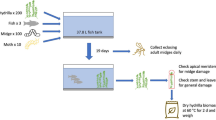Abstract
The efficacy of grass carp Ctenopharyngodon idella (Cyprinidae) and weevils Neochetina spp. (Curculionidae) to control the aquatic weed, water hyacinth, is investigated in a square net cage (happas) setting at a farm in Cuddalore District, South India. This novel combination of insects and fish is found to be superior to individual treatments for controlling the weed growth within 110 d. The biomass of the weed, number of plants, percentage of flowered plants and chlorophyll contents were studied. The weed biomass is reduced from 5 kg (day 1) to 0.33 kg (day 110) when exposed to grass carp and weevils. The number of plants is reduced to 0.75 in grass carp and weevil exposed happas, while it is 741.5 in the control. The mean number of leaves per plant is also reduced. In addition, the chlorophyll a and b are significantly reduced in happas exposed to the combination of fish and insects when compared to the other treatments. Based on the results of this study, we consider the combined use of grass carp and weevils to be more efficient and sustainable for managing water hyacinths than the use of these organisms individually.
Similar content being viewed by others
References
Center T D, Dray F A, Jubinsky G P, Grodowitz M J. 1999. Biological control of water hyacinth under conditions of maintenance management: Can herbicide and insects be integrated? Environmental Management, 23: 241–256.
Chilton E W, Mooneye M I. 1992. Biology and management of grass carp (Ctenopharyngodon idella, Cyprinidae) North America Perspective. Rev. Fish Biol. Fish., 2: 283–320.
Cilliers C J. 1991. Biological control of water hyacinth, Eichhornia crassipes (Pontederiaceae), in South Africa. Agriculture, Ecosystems and Environment, 37: 207–217.
Deloach C J, Corodo H A. 1976. Ecological studies of Neochetina bruchi and N. eichhorniae in Argentina. Journal of Aquatic Plant Management, 14: 53–59.
Gopal B, Sharma K P. 1981. Water hyacinth (Eichhornia crassipes) most troublesome weed of the weed of the world. Hidasia Publishers, New Delhi.
Gopal B. 1987. Water Hyacinth. Elsevier, Amsterdam, Academic Press, New York. p. 471.
Gupta R, Mutiyar P K, Rawat N K, Saini M S, Garg V K. 2007. Development of water hyacinth based vermireactor using an epigeic earth worm Eisenia foetida. Bioresources and Technology, 98: 2 605–2 610.
Holm L G, Plucknett D L, Pancho J V, Herberger J P. 1991. The World’s Worst Weeds: Distribution and Biology. Kreiger Publishing Co., Malabar, University Press of Hawaii, Honolulu, Florida. p.400.
Julian M, Griffiths M W, Wright A D. 1999. Biological Control of Water Hyacinth. ACIAR, Canberra, Australia. p.87.
Lichtenhaler H K. 1987. Chlorophylls and carotenoids: pigments of photosynthetic biomembranes. Methods in Enzymology, 148: 349–382.
Ochiel G R S, Mailu A M, Gitonga W, Njoka S W. 1999. Biological control of water hyacinth on Lake Victoria Kenya. In: Hill M P, Julien M H, Center T D eds. Proceedings of the first IOBC Global Working Group Meeting for the Biological and Integrated Control of Water Hyacinth, Weeds Research Division, ARC, South Africa, p.115–118.
Perkins B D. 1973. Potential for water hyacinth management with biological agents. In: Proceedings of the Tall Timbers Conference on Ecology. Animal Control and Habitat Management, 4. Project Directorate of Biological Control (PDBC), 1994. p.53–64. Fifteen Years of AICRP on Biological Control, Bangalore p.320.
Perkins B D. 1978. Enhancement of effect of Neochetina eichhorniae for biological control of water hyacinth. In: Freeman T E ed. Proceedings of the 4th International Conference on the Biological Control of Weeds Gainesville, Florida. p.87–92.
Wright A D, Center T D. 1984. Predicting population intensity of adult Neochetina eichhorniae (Coleoptera: Curculionidae) from incidence of feeding on leaves of water hyacinth, Eichhornia crassipes. Environmental Entomology, 13: 1 478–1 482.
Author information
Authors and Affiliations
Corresponding author
Additional information
Supported by the Chinese Academy of Sciences Research Fellowship for International Young Researchers to M. Rajkumar hosted by J. SUN, and the Knowledge Innovation Project of the Chinese Academy of Sciences (Nos. KZCX2-YW-QN-205, KZCX2-YW-213-2) to J. SUN
Rights and permissions
About this article
Cite this article
Gopalakrishnan, A., Rajkumar, M., Sun, J. et al. Integrated biological control of water hyacinths, Eichhornia crassipes by a novel combination of grass carp, Ctenopharyngodon idella (Valenciennes, 1844), and the weevil, Neochetina spp.. Chin. J. Ocean. Limnol. 29, 162–166 (2011). https://doi.org/10.1007/s00343-011-0101-z
Received:
Accepted:
Published:
Issue Date:
DOI: https://doi.org/10.1007/s00343-011-0101-z




